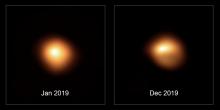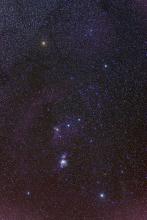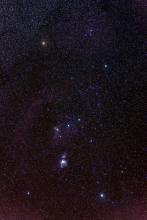Listen to today's episode of StarDate on the web the same day it airs in high-quality streaming audio without any extra ads or announcements. Choose a $8 one-month pass, or listen every day for a year for just $30.
You are here
Betelgeuse III
The rumors of the death of Betelgeuse are greatly exaggerated. The star did stage a big eruption. But it’s still alive and well — although it won’t be for long: It’ll explode as a supernova sometime in the next hundred thousand years.
On the human timescale, that’s pretty much forever. On the timescale of the stars, though, it’s the blink of an eye. The Sun, for example, is four and a half billion years old.
Betelgeuse is only about 10 million to 12 million years old, but the clock is ticking rapidly toward its demise. That’s because Betelgeuse is 15 to 20 times the mass of the Sun. Such heavy stars “burn” through their nuclear fuel in a hurry. They shine brightly but die young.
Betelgeuse has consumed its original hydrogen fuel to make helium. Now, it’s probably burning the helium to make carbon. Over time, it’ll burn through the carbon, then a series of even heavier elements. That will leave it with an onion-like structure, with shells of the different elements around its core.
The core will be converted to iron, but not for long. It won’t be able to “fuse” the iron, so the nuclear reactions will stop. The core will collapse, probably forming a neutron star. But the bulk of the star will be blasted into space — a brilliant ending for a big, beautiful star.
Betelgeuse is the shoulder of Orion. The bright orange star is in the east at nightfall, with the rest of the hunter spreading to its right and lower right.
Script by Damond Benningfield





